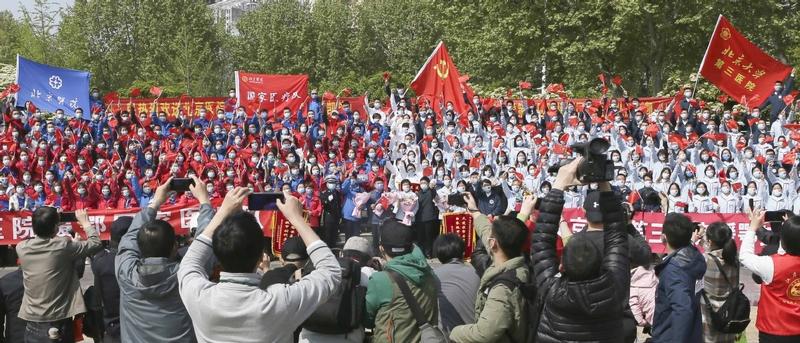 Residents of Wuhan, Hubei province, bid farewell on April 6, 2020 to medical workers from Beijing who are departing after the novel coronavirus has basically been contained in the former epicenter of the outbreak. The medical workers fought the virus for over 70 days in Wuhan. (ZHOU GUOQIANG / FOR CHINA DAILY)
Residents of Wuhan, Hubei province, bid farewell on April 6, 2020 to medical workers from Beijing who are departing after the novel coronavirus has basically been contained in the former epicenter of the outbreak. The medical workers fought the virus for over 70 days in Wuhan. (ZHOU GUOQIANG / FOR CHINA DAILY)
Since Jan 23, when Wuhan, Hubei province, China's core battlefield against the deadly novel coronavirus, came to a halt, the city has witnessed numerous sorrows, but also hope.
With spring arriving, it is gradually returning to normal, and the lockdown is to be lifted on Wednesday.
During the winter, China and its 1.4 billion people experienced the rapidly spreading COVID-19 outbreak. It has caused the most extensive infections and has been the most difficult disease to contain domestically since the founding of New China in 1949.
By Sunday, the pandemic has claimed the lives of 3,331 people and infected 81,708 on the Chinese mainland.
Although the country remains vigilant over imported infections and asymptomatic cases, the darkest moment seems to have passed.
"As China emerges from a two-month containment phase and moves into the mitigation stage, its experience is helping countries currently at the start of the COVID-19 cycle to plan their responses better," the World Health Organization said in its daily situation report for Sunday.
We've managed to contain the outbreak in two to four months, which is unprecedented in the history of epidemics, and unprecedented in the annals of medical history.
Zhang Wenhong, Leader of the Shanghai team of experts treating COVID-19 cases
On Jan 23, when Wuhan imposed the lockdown, 259 confirmed new infections were reported on the mainland. The number continued to rise, peaking at 15,152 on Feb 12.
On Feb 19, the number dropped to three digits, and on March 6, to two digits-where it has remained, with most cases imported, according to the National Health Commission.
Zhang Wenhong, leader of the Shanghai team of experts treating COVID-19 cases, said, "We've managed to contain the outbreak in two to four months, which is unprecedented in the history of epidemics, and unprecedented in the annals of medical history.
"I feel proud of those brave ones, of our country and of our people."
However, while local transmission of the virus has been basically stemmed in China, the outbreak continues to spread worldwide. In recent weeks, Chinese academics and medical workers have been communicating frequently with their foreign peers to see if the country can offer its experience to help contain the pandemic.
They believe the measures that have played a key role-including the Wuhan lockdown, massive testing, strict quarantine regulations and timely treatment-are all fundamental tools to break transmission of the virus.
Experts also point to several other crucial factors. These include: swift national mobilization, especially assistance to Wuhan on a huge scale; cooperation from the public, which made various isolation and social distancing policies a reality; and the country's strong command system with President Xi Jinping as the core, which ensured efficient and synchronized policies in various regions.
It was not an easy decision to seal off Wuhan, a city of more than 11 million people and one of the country's busiest traffic hubs.
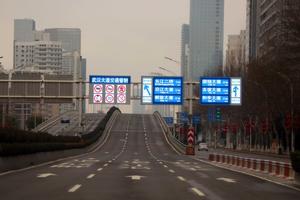 This Feb 7, 2020 photo shows a deserted Wuhan Avenue, a major expressway crossing the the city of Wuhan, capital of Hubei province, China. (ZHU XINGXIN / CHINA DAILY)
This Feb 7, 2020 photo shows a deserted Wuhan Avenue, a major expressway crossing the the city of Wuhan, capital of Hubei province, China. (ZHU XINGXIN / CHINA DAILY)
Even before the lockdown was enforced, Wuhan had the majority of all confirmed COVID-19 cases on the mainland. By Jan 23, there were 495 confirmed infections in the city, accounting for 90 percent of the cases in Hubei, and about 60 percent of the total on the mainland. Nearly all the cases outside the city were found to be linked to Wuhan.
Zhong Nanshan, a member of the Chinese Academy of Engineering and a prominent respiratory disease expert, together with a group of other experts who made a field trip to Wuhan in January, suggested strict control of movement in and out of the city to curb the spread of the virus.
China was experiencing the Spring Festival travel rush, when billions of trips are usually made across the country. However, this would greatly increase the chances of infection nationwide.
On Jan 22, the central leadership ordered Hubei to impose strict controls on outbound travel-a decision Xi described as "very tough" and that took "huge political courage" to make.
On Jan 23, all outbound and inbound flights, rail, bus and ferry services to and from Wuhan were suspended-apart from those required for emergency purposes-effectively isolating the city from the rest of the country. All public transportation in the city, including the subway, buses and taxis were also suspended-a measure aimed at minimizing chances of the virus spreading.
It was an unprecedented move in China's modern history, and other cities in Hubei took similar measures, with the lockdown swiftly extended to the whole province.
Chen Jianguo, vice-president of Huazhong University of Science and Technology and president of Tongji Medical College in Wuhan, said, "The Wuhan lockdown, one of the first major measures taken following the outbreak, has played a pivotal role in containing it."
In the following two months, Wuhan remained the hardest-hit city, but the situation gradually stabilized and improved. On March 11, about 50 days after the lockdown was enforced, newly reported infections in the city dropped to a single digit for the first time.
Zhou Weisheng, a professor at the College of Policy Science at Ritsumeikan University in Kyoto, Japan, said: "If China had not imposed the lockdown in Wuhan and some other cities, the number of people infected with the virus may have been more than 10 times higher. Considering the lack of effective prevention and treatment methods for COVID-19, cutting off the source of infection (by locking down Wuhan and some other cities) resolutely and as soon as possible should be the first measure taken, despite the great cost."
A number of published research studies have also illustrated the significance of the unprecedented measure.
According to a study published in the journal Science on March 31, the Wuhan lockdown, together with the national emergency response, reduced the number of confirmed COVID-19 cases outside Wuhan on the mainland by 96 percent within a month of being implemented. Without the lockdown, by Feb 19, the number of such confirmed cases would have reached more than 740,000, instead of fewer than 30,000, the study found.
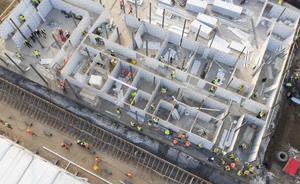 This Jan 30, 2020 photo shows the Huoshenshan Hospital in Wuhan under construction. The temporary facility was completed within 10 days. (CAI YANG / XINHUA)
This Jan 30, 2020 photo shows the Huoshenshan Hospital in Wuhan under construction. The temporary facility was completed within 10 days. (CAI YANG / XINHUA)
Test, treat and isolate
After the outbreak emerged, China ordered all-out efforts to provide viral tests and treatment for all those in need, and imposed isolation measures on confirmed and suspected cases, and close contacts of confirmed infections. This was seen as another crucial measure that helped flatten the curve of new infections.
At the end of January, the outbreak had spread extensively in communities in Wuhan, according to Vice-Premier Sun Chunlan, who heads a central government work team for COVID-19 epidemic control in Hubei. A large number of patients kept moving between hospitals and their communities, posing a severe challenge for control and prevention work.
In early February, under the guidance of the team, the authorities in Wuhan intensified efforts to identify all cases and close contacts in residential communities and sent them to designated hospitals and other facilities for treatment or medical observation under isolation.
Given the high infection rate and the lack of medical resources at the time, this was an extremely arduous task.
In about two weeks, the authorities in Wuhan had inspected 4.2 million households in the city and identified 18,000 confirmed and suspected COVID-19 cases and close contacts of confirmed patients. They were all sent to hospitals and other designated facilities, according to official data.
Wang Chen, president of the Chinese Academy of Medical Sciences, said the central government's decision to provide free tests and treatment for all people in need played the most important role in controlling the outbreak.
In the early stages of the outbreak in Wuhan, a major challenge to universal testing-a precondition for all cases being received by medical facilities-was the lack of capacity, which lagged behind the rapidly rising demand from patients, Wang said.
"In the beginning, only centers for disease control and prevention could provide viral nucleic acid tests," he said. "Later, many hospitals could give the tests, which greatly eased the problem."
However, with the fast-growing number of people needing medical treatment or to be quarantined, Wuhan faced another critical problem-the lack of hospital beds.
As the city's medical resources were far from sufficient to cope with the peak of the outbreak, two temporary facilities-the Huoshenshan Hospital and Leishenshan Hospital-were completed within two weeks in early February, providing a total of more than 2,000 beds for patients in critical condition.
The city's sports stadiums, exhibition halls and warehouses were also transformed into makeshift hospitals, or Fangcang shelter hospitals, to take patients with mild symptoms.
 Medical workers take patients to wards at Huoshenshan Hospital in Wuhan on Feb 4, 2020, when the temporary facility was put into operation. (XIAO YIJIU / XINHUA)
Medical workers take patients to wards at Huoshenshan Hospital in Wuhan on Feb 4, 2020, when the temporary facility was put into operation. (XIAO YIJIU / XINHUA)
Wuhan resident Feng Bangli was cured of COVID-19 and discharged from a makeshift hospital at the end of February. "I could not find a bed at any designated regular hospital in Wuhan, as there were so many patients. So, in early February, I had to stay at a designated hotel for isolation," he said. "When the Fangcang shelter hospital was set up, I saw hope."
With temporary hospitals built and existing ones expanded, the shortage of beds was no longer a problem in Wuhan. All patients could now be admitted to hospitals, which helped effectively control the infection source, said Tang Zhouping, a professor of neurology at Tongji Hospital and also president of Guanggu Fangcang Shelter Hospital-a temporary facility transformed from an exhibition center.
Building makeshift hospitals was a key decision made at a critical time when Wuhan faced a formidable task in epidemic control, and was also "a core measure" in implementing the policy to test, treat and isolate all those in need, said Wang Chen, from the Chinese Academy of Medical Sciences
Wang Chen, from the Chinese Academy of Medical Sciences, said building makeshift hospitals was a key decision made at a critical time when Wuhan faced a formidable task in epidemic control, and was also "a core measure" in implementing the policy to test, treat and isolate all those in need.
"In addition to providing treatment for patients, such hospitals are, first of all, ideal sites for quarantined patients so that they do not spread the disease," he said. "In addition, as such hospitals only receive patients with mild symptoms, many of them will not end up in designated hospitals, so critically ill patients have more chances of being admitted."
The 16 temporary hospitals, which offered about 14,000 beds, were all closed by March 10 due to a fall in the number of patients. The hospitals received more than 12,000 COVID-19 patients in Wuhan, accounting for nearly 25 percent of all those in the city, according to the National Health Commission.
Richard Horton, editor-in-chief of The Lancet, a medical journal based in the United Kingdom, wrote on his Twitter account on April 3: "Fangcang shelter hospitals were critical elements in China's successful response to SARS-COV-2. They were large, quickly repurposed and cost-effective. They stopped intrafamilial transmission, reduced hospital pressures and enabled efficient triage."
Meanwhile, Tang said the measure to isolate all patients who recovered, suspected cases and close contacts of all confirmed patients for 14 days at designated quarantine sites, and require self-observation at home for another 14 days, was also an important factor.
Official data show that more than 530 hotels, training centers and recreational venues in Wuhan have been transformed into quarantine sites.
While there is still no specific medicine or vaccine to treat COVID-19, Chinese health experts are exploring a treatment that combines traditional Chinese medicine and Western medicine.
Of all confirmed cases on the mainland, more than 90 percent have received TCM treatment, and this has been effective in over 90 percent of them, according to the National Administration of Traditional Chinese Medicine.
Yu Yanhong, Party chief of the administration, said late last month TCM treatment could significantly relieve symptoms in COVID-19 patients, while preventing the condition worsening among those with mild symptoms. "It has been proven that TCM can improve the recovery rate, while reducing the death rate effectively," Yu said.
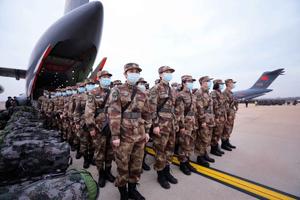 Some of the medical workers sent to Wuhan by military transport aircraft on Feb 13, 2020. (CHEN XIAODONG / FOR CHINA DAILY)
Some of the medical workers sent to Wuhan by military transport aircraft on Feb 13, 2020. (CHEN XIAODONG / FOR CHINA DAILY)
Resource allocation
For more than two months, Wuhan has been the core battlefield in fighting the outbreak in China, but it has not been doing so alone.
Unlike other areas of the country, which have witnessed far fewer COVID-19 cases, the city's healthcare system faced an excessive burden during the initial period of the outbreak.
Faced with this grim situation, the PLA Air Force began using its transport planes to send military medics and materials to Wuhan on Jan 24. Three aircraft carried 450 medical workers and supplies to the city before midnight that day-Lunar New Year's Eve.
More than 42,000 medical professionals from across the country went to Hubei to help their local peers battle the disease.
Meanwhile, the daily supply of protective medical gowns to Hubei rose from about 21,000 before Jan 27 to 270,000 at the peak on Feb 29, while the daily supply of N95 face masks had risen nearly eightfold by March 1, according to official data.
Jiao Yahui, an official responsible for medical administration and supervision at the National Health Commission, said medical teams from outside Hubei have played a crucial role.
She said that during the peak of the outbreak, the shortage of medical workers in Hubei reached about 10,000 a day as the number of patients rose rapidly. Due to the assistance of medical workers from outside Hubei, all patients received treatment, and the mortality rate in the province dropped significantly.
Wang Zhen, vice-president of Shanghai Mental Health Center, who led a medical team from the metropolis to aid Hubei, said that thanks to the country's rapid response system and mobilization ability, doctors and nurses from across the nation were sent to Hubei quickly.
"China does not have very prominent advantages in medical technologies, but it performed remarkably well in pooling medical resources for rescue efforts in the fight against the epidemic," he said.
Li Yiping, an economics professor at Renmin University of China in Beijing, said the central government can mobilize national resources quickly, such as marshaling enterprises to produce masks in large quantities and send them to hospitals and other places where they are urgently needed.
He said these efforts prevented speculation about medical materials, and ensured "scientific allocation" so that demand from frontline medical workers and the public for self-protection could be met.
In addition to medical resources, a coordination mechanism between Hubei and eight other regions-Shandong, Anhui, Jiangxi, Henan, Hunan and Yunnan provinces, Chongqing and Guangxi Zhuang autonomous region-was set up on Jan 23 to ensure daily necessities reached residents in Hubei.
By March 27, about 72,000 metric tons of daily supplies, such as vegetables, fruit and instant food, had been sent to the province to meet demand, according to official data.
 Supermarket workers prepare vegetables for delivery to a residential community in Wuhan on March 11, 2020. (CHEN LIANG / FOR CHINA DAILY)
Supermarket workers prepare vegetables for delivery to a residential community in Wuhan on March 11, 2020. (CHEN LIANG / FOR CHINA DAILY)
Social distancing
When Wuhan was sealed off, a range of measures was taken in the rest of the country to prevent local transmission of the virus.
By Jan 30, all 31 provincial-level regions on the mainland had activated the first-level emergency response to contain the spread of COVID-19.
Authorities and medical experts kept appealing to the public to comply with the measures, such as staying at home as much as possible, maintaining social distancing, wearing a mask when going outside and washing hands frequently.
Public places, such as museums, cinemas and scenic spots in many cities closed temporarily, and the opening of the spring semester at schools was postponed.
Comments from Zhang, the doctor in Shanghai, soon became popular with the public, including: "You're at home not for quarantine, but for the fight!"; "As of now, everyone of us is the fighter!"; and "Stay at home for two weeks to suffocate the virus".
Zhang said he believed the Spring Festival holiday, which was extended from seven days to 10, gave the nation longer for home isolation, which was highly effective in reducing the spread of the virus.
Passenger trips have slumped by more than 50 percent this year-falling to nearly 1.48 billion during the 40-day Spring Festival travel rush that started on Jan 10, according to the country's top transportation authority. On Jan 29, daily passenger trips nationwide fell by 83.5 percent compared with the holiday period last year.
Local communities have been given management tasks. Community workers have to take the temperature of everyone entering a residential area and obtain the health details of those living in an area who arrive from elsewhere.
Liu Jinlong, a professor of agriculture and rural area development at Renmin University of China, said, "Communities are at the frontline of epidemic control this time, and our efforts to improve community management in recent years have paid off.
"In places where more progress has been made in community management, such as the Pearl River Delta and Yangtze River Delta, epidemic control measures appear to be more timely and effective."
Official data show that about 4 million employees are working in some 650,000 communities nationwide. On average, six staff members serve one community, with one worker for about 350 people.
In addition to disease control, they buy food and drugs for residents in quarantined households, to help ensure that life continues as normally as possible. The country's robust service sector has also made home isolation bearable for the public, thanks to the hard work of numerous delivery riders.
Wang Zhen, from the Shanghai Mental Health Center, said the public has overcome many difficulties arising from regulations to restrict their movement, and has been complying well with isolation measures.
He said traditional Chinese culture emphasizes collectivism, rather than individualism. "For us, the nation is the biggest collectiveness, and collectivism will be activated when the nation faces a major disaster, so that we can carry out various disease control measures better than people in some Western countries," he added.
The prompt release of information and knowledge about the virus has also helped reassure the public.
On Jan 21, the National Health Commission began issuing a daily report on COVID-19 numbers, and since Jan 27, the Joint Prevention and Control Mechanism of the State Council has been holding a daily news conference on the outbreak. Local government representatives in Hubei and other areas, including Beijing, are also meeting the media every day.
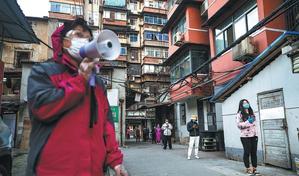 In this undated photo, a volunteer informs a community in Wuhan of a meat delivery. (YUAN ZHENG / FOR CHINA DAILY)
In this undated photo, a volunteer informs a community in Wuhan of a meat delivery. (YUAN ZHENG / FOR CHINA DAILY)
Command system
All these measures could not have been possible without a strong command system, experts said.
Hu Angang, president of the Institute for Contemporary China Studies at Tsinghua University, said that after the outbreak emerged, China established a quasi wartime work mechanism led by the country's top leader.
Since Jan 25, Lunar New Year's Day, President Xi, also general secretary of the Communist Party of China Central Committee, has chaired eight meetings of the Standing Committee of the Political Bureau of the CPC Central Committee, two meetings of the Political Bureau of the CPC Central Committee, and has delegated work related to disease control and social development.
Wang Linggui, president of the Chinese Academy of Social Sciences' Information Research Institute, said Xi has been leading the war against the outbreak, has issued directions on many occasions and has outlined major plans.
On Jan 25, a leading group for epidemic control, headed by Premier Li Keqiang, was set up by the CPC Central Committee.
Two days later, a central government work group, headed by Vice-Premier Sun Chunlan, arrived in Wuhan to guide epidemic control work in Hubei.
In addition, a joint working mechanism comprising 32 central government departments was established in late January to promote coordination among various departments for epidemic control and prevention work.
Hu said, "The mechanism, which includes epidemic control, medical treatment, scientific research, publicity and logistics, serves to carry out decisions from the top.
"The implementation and working mechanism, with the most distinctive Chinese characteristics, is responsible for coordinating and mobilizing all types of resources nationwide."
At local level, governments have been ordered to shoulder their responsibilities and take strong action to curb the disease, otherwise officials will be held "resolutely accountable".
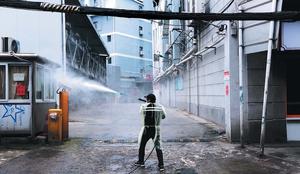 A worker disinfects a neighborhood in Wuhan, Hubei province, on Feb 10, 2020. (ZHANG ZHENG / FOR CHINA DAILY)
A worker disinfects a neighborhood in Wuhan, Hubei province, on Feb 10, 2020. (ZHANG ZHENG / FOR CHINA DAILY)
Lai Xianjin, an associate professor of public management at the National Academy of Governance, said China has used its experience in coping with major emergencies and disasters, including the Wenchuan earthquake in 2008 and the fight against Severe Acute Respiratory Syndrome, or SARS, in 2003. For example, each city in Hubei has received assistance from at least one provincial-level region.
"China has shown excellent national governance capacity," Lai said, adding that the country's unique system has ensured high efficiency-for example, in mobilizing resources when faced with a major disaster.
However, Xi has said that the outbreak is "both a crisis and a big test for us". He required experience to be summed up and lessons to be learned, as the outbreak has exposed weak points in the country's system of epidemic prevention and control, and in the system of public health emergency.
China has shown excellent national governance capacity.
Lai Xianjin, Associate professor of public management at the National Academy of Governance
He has called for stronger legal support for public health, a better disease prevention and control system, an improved medical insurance and assistance system for major diseases, as well as a structure to safeguard emergency resources.
Battle continues
According to the National Health Commission, the falling number of patients means that COVID-19 has been largely contained on the mainland, but the risk of a new wave of cases remains, due to the global pandemic.
On Sunday, 39 new confirmed infections were reported on the mainland, with 38 of them imported, bringing the total number of imported cases to 951, the commission said.
Worldwide, 209 countries, regions and territories have reported 1.17 million confirmed cases, with 64,471 deaths, according to the WHO.
In view of imported infections, China has made greater efforts to prevent the virus crossing its borders, has cut international flights and appealed to the public to suspend outbound trips unless they are absolutely necessary.
The country is also providing humanitarian aid to other nations and international organizations battling the pandemic. Large numbers of face masks, testing kits and protective suits have been transported from China to countries around the world. Factories are operating round-the-clock to produce ventilators and protective equipment for urgent overseas orders, on top of meeting domestic demand.
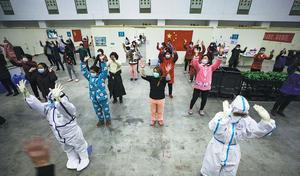 Patients led by medical workers exercise at a makeshift hospital on Feb 18, 2020. (CHEN ZHUO / FOR CHINA DAILY)
Patients led by medical workers exercise at a makeshift hospital on Feb 18, 2020. (CHEN ZHUO / FOR CHINA DAILY)
With the lockdown in Wuhan due to be lifted, the city's residents can finally look forward to life returning to normal.
Xu Duo, a designer at an advertising company in the city, said his immediate family and all his friends and relatives have been strictly adhering to the measures to restrict movement, despite the inconvenience.
"I felt nervous in the first few days of the lockdown, but soon felt assured as I saw so much help arriving from across the country, including medical workers and a large amount of materials being delivered," he said.
Bruce Aylward, a senior adviser to the director-general of the WHO, has spoken highly of the contribution made by Wuhan residents.
After making a trip to Wuhan in February, he said: "The city of skyscrapers, giant auto routes and a gorgeous hypermodern train station was silent. It was a ghost town, and behind every window of these skyscrapers we drove past, there were people. There were 15 million people staying put in one place for weeks at a time to stop this disease.
"I just thought it's so important that we recognize the people of Wuhan. It is recognized that the world is in your debt," he said.
It's not just the city's people that should be given credit, but the entire country.
President Xi said the Chinese nation has experienced many ordeals in its history, but has never been overwhelmed. Instead, it has become more and more courageous, growing up and rising up from the hardships.
No victory should be lightly announced until it is complete, he said.

Wang Yiqing, Liu Jianna, Pan Yixuan and Zhou Wenting contributed to this story.
Contact the writers at wangxiaodong@chinadaily.com.cn


